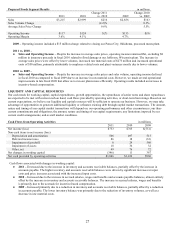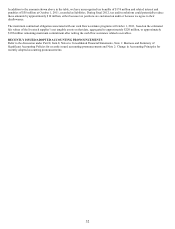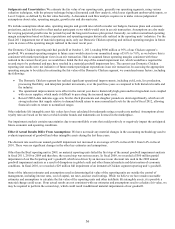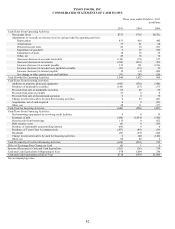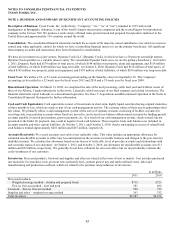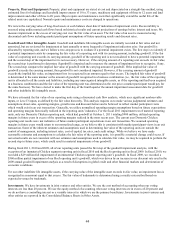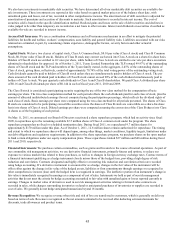Tyson Foods 2011 Annual Report Download - page 37
Download and view the complete annual report
Please find page 37 of the 2011 Tyson Foods annual report below. You can navigate through the pages in the report by either clicking on the pages listed below, or by using the keyword search tool below to find specific information within the annual report.
37
If the Domestic Chicken reporting unit experienced a 15% or more decline in fair value at July 1, 2011, it would have caused the
carrying value of the reporting unit to be in excess of fair value, which would have required the second step to be performed.
Additionally, valuing the Domestic Chicken reporting unit utilizing projected operating margins averaging less than 4.0%, or a 0.9%
increase in the discount rate used in fiscal 2011, would have caused the carrying value of the Domestic Chicken reporting unit to be in
excess of fair value, which would have required the second step to be performed. The second step may have resulted in a material
goodwill impairment loss. All other material reporting units’ estimated fair value exceeded their carrying value by more than 20%.
Consequently, we do not consider any of our other material reporting units at significant risk of failing the first step of the annual
goodwill impairment test.
Our fiscal 2011 other indefinite life intangible asset impairment analysis did not result in a material impairment charge. A hypothetical
20% decrease in the fair value of intangible assets would not result in a material impairment.
ITEM 7A. QUANTITATIVE AND QUALITATIVE DISCLOSURES ABOUT MARKET RISK
MARKET RISK
Market risk relating to our operations results primarily from changes in commodity prices, interest rates and foreign exchange rates, as
well as credit risk concentrations. To address certain of these risks, we enter into various derivative transactions as described below. If
a derivative instrument is accounted for as a hedge, depending on the nature of the hedge, changes in the fair value of the instrument
either will be offset against the change in fair value of the hedged assets, liabilities or firm commitments through earnings, or be
recognized in other comprehensive income (loss) until the hedged item is recognized in earnings. The ineffective portion of an
instrument’s change in fair value is recognized immediately. Additionally, we hold certain positions, primarily in grain and livestock
futures that either do not meet the criteria for hedge accounting or are not designated as hedges. With the exception of normal
purchases and normal sales that are expected to result in physical delivery, we record these positions at fair value, and the unrealized
gains and losses are reported in earnings at each reporting date. Changes in market value of derivatives used in our risk management
activities relating to forward sales contracts are recorded in sales. Changes in market value of derivatives used in our risk management
activities surrounding inventories on hand or anticipated purchases of inventories are recorded in cost of sales.
The sensitivity analyses presented below are the measures of potential losses of fair value resulting from hypothetical changes in
market prices related to commodities. Sensitivity analyses do not consider the actions we may take to mitigate our exposure to
changes, nor do they consider the effects such hypothetical adverse changes may have on overall economic activity. Actual changes in
market prices may differ from hypothetical changes.
Commodities Risk: We purchase certain commodities, such as grains and livestock, in the course of normal operations. As part of our
commodity risk management activities, we use derivative financial instruments, primarily futures and options, to reduce the effect of
changing prices and as a mechanism to procure the underlying commodity. However, as the commodities underlying our derivative
financial instruments can experience significant price fluctuations, any requirement to mark-to-market the positions that have not been
designated or do not qualify as hedges could result in volatility in our results of operations. Contract terms of a hedge instrument
closely mirror those of the hedged item providing a high degree of risk reduction and correlation. Contracts designated and highly
effective at meeting this risk reduction and correlation criteria are recorded using hedge accounting. The following table presents a
sensitivity analysis resulting from a hypothetical change of 10% in market prices as of October 1, 2011, and October 2, 2010, on the
fair value of open positions. The fair value of such positions is a summation of the fair values calculated for each commodity by
valuing each net position at quoted futures prices. The market risk exposure analysis includes hedge and non-hedge derivative
financial instruments.
Effect of 10% change in fair value
in millions
2011
2010
Livestock:
Cattle
$34
$39
Hogs
57
42
Grain
11
10


